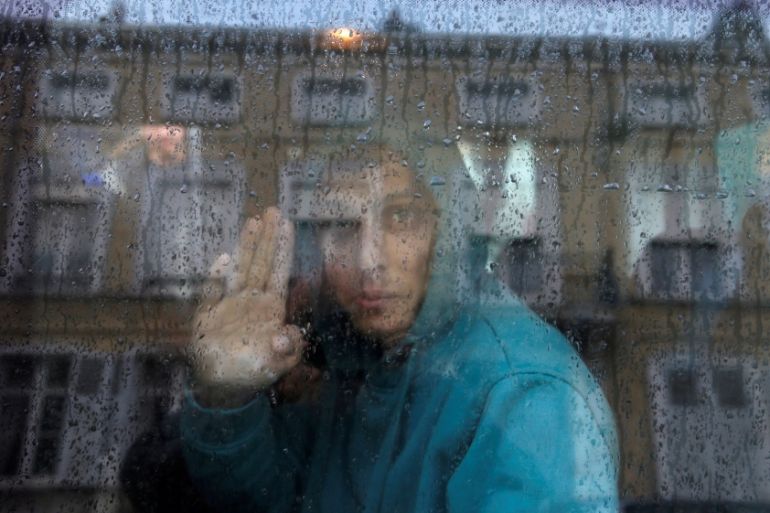Demonising children at US and European borders
The US government’s tried to deflect criticism of its family separation policy by presenting children as a threat.

On June 30, thousands marched in 700 cities across the United States to demand the end of the Trump administration’s deplorable immigration policies. The protests came after images and audio recordings of small children being separated from their parents and being kept in cages were circulated in the media and caused nation-wide outrage.
As the media storm was picking up, the US government tried hard to push a different narrative. It released photos and footage from one of the detention centres where children are kept, foregrounding teenage boys and rendering girls, younger boys, and toddlers much less visible.
Keep reading
list of 4 itemsUN report charts lethal cost of migration over past decade
Conflict, climate, corruption drive Southeast Asia people trafficking: UN
Bodies of three Rohingya found as Indonesia ends rescue for capsized boat
By doing so, the government sought to break down “children” into two categories – those who deserve sympathy and those who do not because, in fact, they are “grown-up” boys. It also sought to deflect the public debate from the issue of human rights and humanity to the issue of national security.
In a June 18 press conference, Kirstjen Nielsen, the US Secretary of Homeland Security, was challenged on the problematic nature of the imagery released by her government. A Politico reporter asked why they were only releasing images of boys; where were the pictures of girls and toddlers? Nielsen obfuscated repeatedly and eventually declared “I’ll look into that,” before moving on to another question.
This strategy of pushing “threatening” teenage refugees or migrants to the foreground in order to diminish public sympathy is not exclusive to the US government.
In October 2016, a similar kind of imagery was being circulated in the UK media: the pictures of children who had been living informally near the French city of Calais and were entering the UK to join their families. These were again pictures almost exclusively of teenage boys – or “burly lads” as they were called – many from Syria and Afghanistan.
In the anti-immigration press, the images were accompanied by suggestions that these boys were not children at all and that they should be subjected to dental tests to “prove” they were in fact under 18.
|
|
While (white) childhood is often seen as a paragon of innocence, non-white teenagers, it has been suggested, could potentially be a threat. We have been invited to read them as independent and intimidating, and not in need of care and protection. Somehow it was the US and UK that needed protection, rather than the children stranded at their borders; the feminised US and UK were threatened by the presence of these hyper-masculinised youths.
Foregrounding non-white teenage boys in both the US and the UK was employed to justify the separation of children from their families. But it’s not just anti-immigrant governments and media outlets that are perpetuating these narratives, which relegate refugee and immigrant teenage boys to a place outside of childhood.
Even humanitarian organisations seem unsure of how to work with non-white teenagers and men. They are often deemed “less vulnerable” and, therefore, less deserving of care and protection.
This idea has affected how some refugee camps have been set up in Greece, for example, where single refugee men and teenage boys are kept separate from families and under heavier police presence. As a result, young boys often experience violence, being victimised by older men, while their requests to be moved to the family sections are denied.
These practices of separating children from families and keeping teenage boys isolated, both in the US and Europe, are the continuation of long-standing colonial policies. They reflect deeply-ingrained, well-established patterns of politics far older than President Donald Trump’s and Prime Minister Theresa May’s policies.
In the US, not that long ago, African American and Native American children were being separated from their families as part of slavery and forced assimilation policies. And even under the much-celebrated Obama administration, family separation was also being practised; in 2013, for example, some 72,000 families were torn apart due to deportations.
The UK has a similar colonial legacy. Apart from playing a major role in the slave trade, it also brought tremendous suffering to the Middle East and South Asia through its colonial partition practices which to this day keep many families apart.
More recently, UK immigration policies were on the verge of ripping apart British families as members of the “Windrush generation” were threatened with deportation. While May promised to resolve the issue, other UK citizens are still struggling to bring their families to the country as stringent income requirements prevent them from obtaining visas for their non-EU spouses and children.
In this sense, claiming that Trump’s and May’s policies are “un-American” or “un-British” is clearly false and they should not be kept separate from their historical and racist context.
And today, as people rightly rush to protest, raise awareness, and gather resources to challenge the separation of families and the incarceration of children and adults for crossing borders, we must stay alert to the damaging narratives being pushed by the government in the US and elsewhere.
We must make sure that it is clear we are standing up for all children, regardless of their gender and age and for all adults, regardless of their race and religion, to be able to cross borders and seek asylum in a safe and dignified way.
The views expressed in this article are the author’s own and do not necessarily reflect Al Jazeera’s editorial stance.
